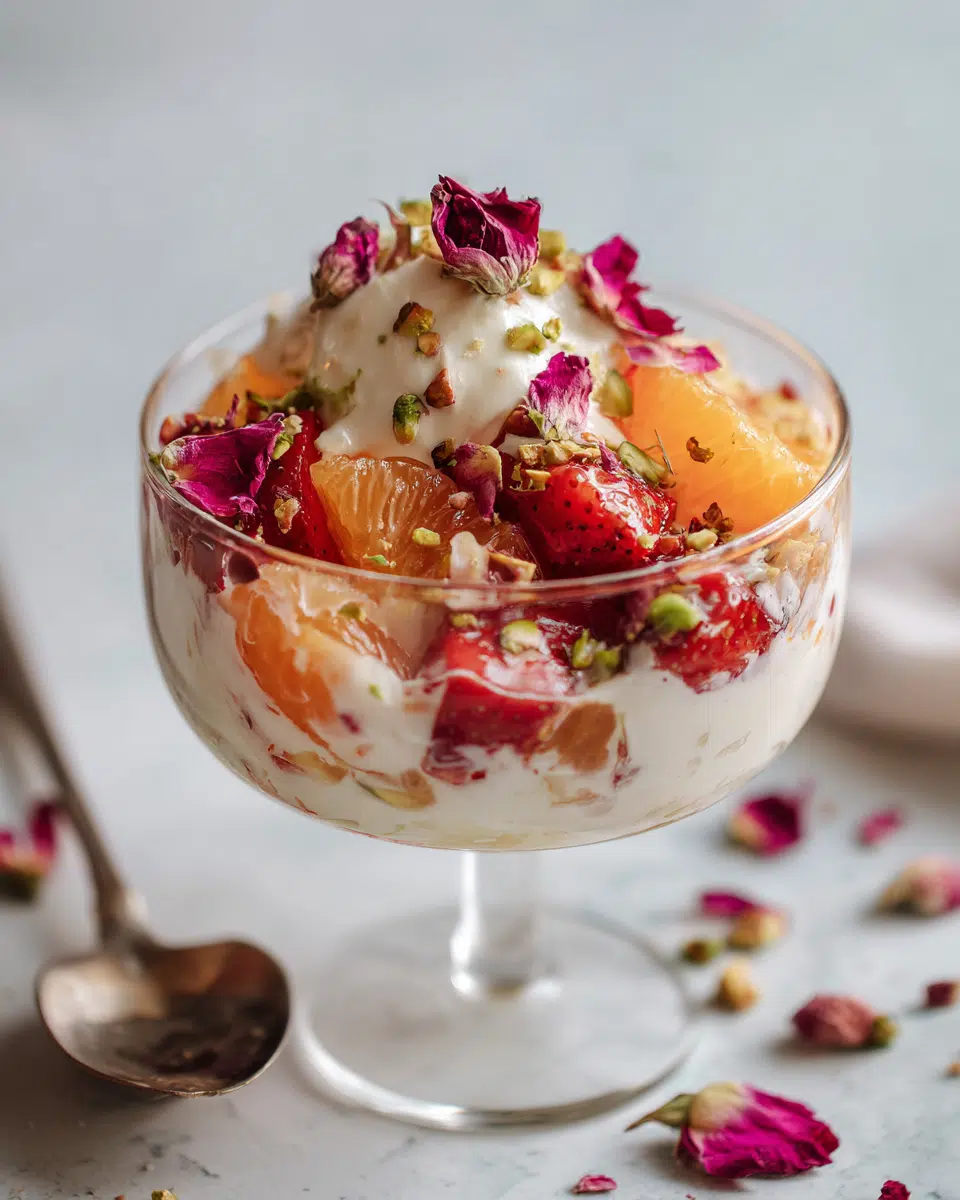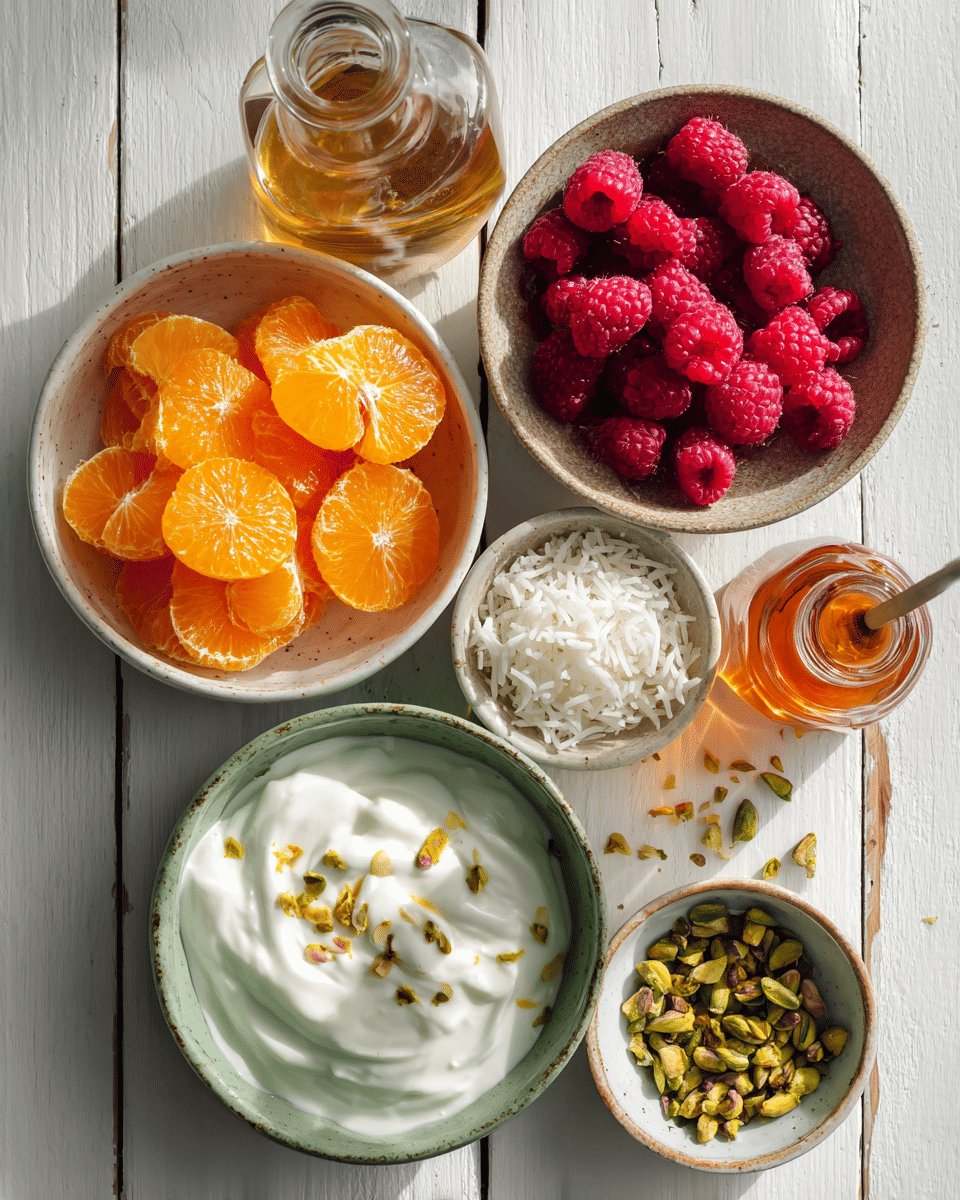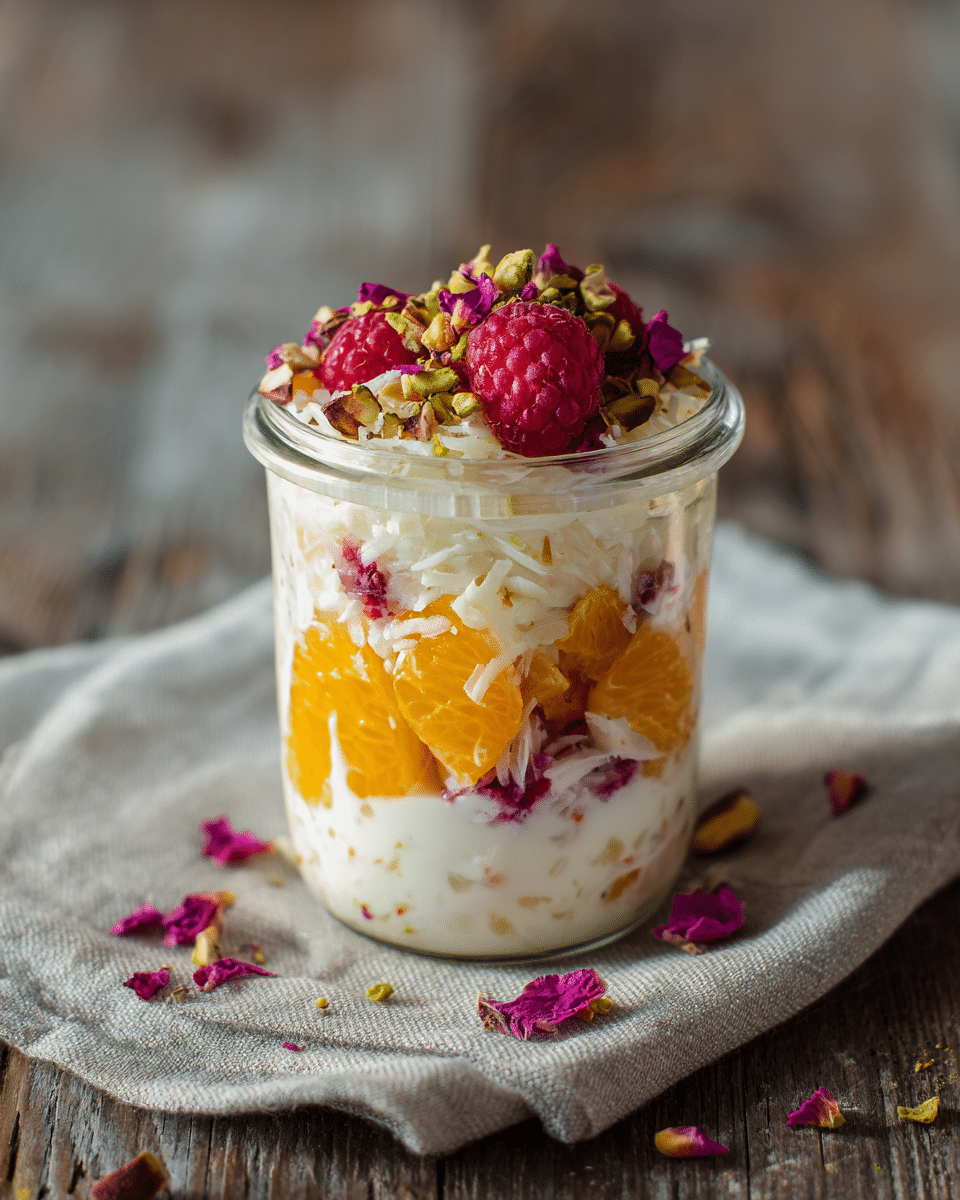
Table of Contents
An elegant revival of a nostalgic classic, reimagined with floral notes and nutty crunch
Once a retro icon of potlucks and pastel-colored luncheons, Ambrosia Salad has stepped back into the spotlight—but this time with a refined, modern flair. This updated recipe leaves behind the syrupy fruit cocktails and heavy creams of the past. Instead, it introduces a new wave of freshness: juicy mandarin oranges, ripe summer berries, airy coconut cream, and the subtle allure of rosewater.
Finished with crunchy toasted pistachios and delicate shreds of coconut, this Modern Ambrosia Salad is as beautiful as it is refreshing. Whether you’re serving it for brunch, dressing up a summer dinner party, or indulging in a cooling no-bake dessert, this dish brings timeless charm with contemporary flavor. It’s still sweet, still creamy—but with lighter textures, elevated ingredients, and a more balanced bite.
Ready to fall in love with Ambrosia Salad all over again? Let’s begin with how this dreamy dish earned its divine name—and why it still deserves a place on your table today.
The Revival of a Classic — Modern Ambrosia Salad Recipe
The Modern Ambrosia Salad Recipe is a beautiful reimagining of a nostalgic American favorite. Once a staple of potlucks and vintage cookbooks, this fruit-filled dessert now returns with a fresh, elevated twist—designed for the modern table. Gone are the days of syrupy canned fruit and overly sweet whipped topping. In their place: vibrant citrus, fresh berries, airy coconut cream, floral rosewater, and a pistachio crunch.
This reinvented recipe celebrates texture, balance, and beauty. It’s dairy-optional, naturally sweetened, and stunning in presentation—making it ideal for spring brunches, garden parties, or no-bake summer desserts.
The Modern Ambrosia Salad Recipe fits seamlessly into the new wave of lighter, more elegant retro desserts. If you’re drawn to sweet dishes that blend comfort with creativity, you’ll also love our Roasted Figs with Whipped Greek Yogurt & Honey.
In this guide, we’ll explore how this floral-forward version of Ambrosia Salad works, what makes it different, how to troubleshoot issues like “Why is my Ambrosia Salad watery?”, and how long you can keep it fresh in the fridge. Along the way, we’ll also answer questions like “What is a fun fact about Ambrosia Salad?” and how this dish has earned its divine name.
Ingredients Breakdown & Smart Substitutions
What truly elevates this Modern Ambrosia Salad Recipe is the balance between fresh, vibrant ingredients and subtle, floral complexity. Unlike traditional versions that rely on canned fruit and whipped topping, this modern take highlights real textures and naturally sweet elements.
Every ingredient has a purpose: to create contrast, to add fragrance, and to offer creamy, crunchy satisfaction in every bite. This version is lighter, more customizable, and far more visually appealing—perfect for a brunch spread or an elegant no-bake dessert.
Core Ingredients
- Mandarin oranges – Fresh or jarred segments, thoroughly drained. They provide brightness and juicy contrast to the cream base.
- Raspberries or strawberries – These berries add acidity and natural sweetness. Blueberries or pomegranate seeds can also be used.
- Unsweetened shredded coconut – Adds texture and a subtle tropical note without overpowering the cream.
- Rosewater – A little goes a long way. This brings gentle floral undertones that lift the fruit and cream beautifully.
- Coconut cream or Greek yogurt – Your creamy foundation. Coconut cream gives a dairy-free, lush texture, while Greek yogurt adds protein and tang.
- Mini marshmallows (optional) – A nod to the traditional Ambrosia Salad. For a cleaner version, simply omit them or replace with chopped fruit.
- Toasted pistachios – Provide nutty crunch and elegant contrast. Always toast them fresh for maximum flavor.
Smart Substitutions
- Replace rosewater with orange blossom water if you prefer citrusy floral notes.
- Swap pistachios for roasted almonds or macadamias, depending on preference or allergy needs.
- Use low-fat yogurt if desired, but full-fat yields better texture and less risk of watery salad.
This Modern Ambrosia Salad Recipe is easy to adapt for different diets. Make it vegan, gluten-free, or refined-sugar-free by adjusting just a few components.

Step-by-Step Recipe — Modern Ambrosia Salad with Rosewater & Pistachios
This refined version of Ambrosia Salad brings together vibrant citrus, juicy berries, floral notes, and nutty crunch, all held together by a creamy base. The preparation is simple, but precision matters when it comes to texture and balance.
Ingredients
Fruit and Texture
- 1 cup mandarin orange segments (fresh or jarred, well drained)
- 1 cup strawberries or raspberries, chopped
- ½ cup unsweetened shredded coconut
- ¼ cup pomegranate seeds (optional)
- ⅓ cup mini marshmallows (optional)
Cream Base
- ¾ cup chilled coconut cream or full-fat Greek yogurt
- 1 tablespoon honey or maple syrup (adjust to taste)
- 1 teaspoon rosewater (start with ½ teaspoon and increase if desired)
Topping and Garnish
- ¼ cup pistachios, lightly toasted and chopped
- Optional: edible rose petals or fresh mint leaves for garnish
Instructions
- Prepare the fruit
Wash and dry all fruit thoroughly. Slice strawberries or raspberries into bite-sized pieces. If using mandarin segments from a jar, drain them well and pat dry with paper towels. - Toast the pistachios
In a dry skillet over medium heat, toast the pistachios for 2–3 minutes until fragrant. Let them cool, then chop roughly. - Make the cream base
In a bowl, whisk together the chilled coconut cream or Greek yogurt with honey and rosewater. Start with a small amount of rosewater and taste as you go—too much can overpower the dish. - Combine the base and fruit
In a large mixing bowl, add the prepared fruit, coconut, and marshmallows (if using). Gently fold in the cream base using a spatula. Do not overmix, as the fruit may release moisture and break down. - Chill the salad
Cover the bowl and refrigerate for at least 30 minutes before serving. This helps the flavors meld and firms up the cream base. - Finish and garnish
Just before serving, sprinkle the chopped toasted pistachios on top. Add edible rose petals or mint leaves for an elegant finish. - Serve immediately
For best texture, serve chilled in small dessert bowls or coupe glasses. Avoid leaving the salad at room temperature for extended periods.
Why This Modern Ambrosia Salad Works — Flavor Science & History
The success of this Modern Ambrosia Salad Recipe lies in its thoughtful reinvention. By combining timeless comfort with updated textures and flavors, it creates something that feels both familiar and exciting. But to understand why it works so well today, it helps to look at the original inspiration.
A Bit of History
Ambrosia Salad has deep roots in American culinary history. The earliest recorded version appeared in the 1860s and consisted of only three ingredients: orange slices, grated coconut, and sugar. At the time, these ingredients were exotic luxuries in many parts of the United States. The dish earned its name—“ambrosia,” the mythical food of the gods—because it was seen as an indulgent delicacy.
Over the decades, the salad evolved. By the 1950s, it had become a staple of Southern potlucks and holiday tables. Canned fruit cocktail, sour cream or whipped topping, maraschino cherries, and mini marshmallows became standard. It was festive, sweet, and easy to make—qualities that made it a household favorite, but also dated its appeal.
Today’s version revives that essence of indulgence, but with a refined approach.
Why This Version Stands Out
This modern version avoids excessive sweetness and artificial texture. Instead, it relies on fresh fruit for brightness, coconut cream or Greek yogurt for smoothness, and rosewater to introduce a floral layer that gives the dish complexity. The pistachios, lightly toasted, cut through the creaminess and provide a contrasting crunch.
Modern eaters want flavor depth, health-conscious flexibility, and beautiful presentation. This version delivers all three.
What is a fun fact about Ambrosia Salad?
Here’s something many don’t know: Ambrosia Salad was originally served as a chilled fruit course between dinner and dessert—not as a dessert itself. It was considered elegant enough for formal dining but simple enough for home cooks. That balance of simplicity and sophistication is exactly what today’s Modern Ambrosia Salad Recipe reclaims.
You can read more about elevated vintage desserts like this in our Retro Dessert Makeover Series, which explores classics reimagined for modern tables.

Serving Ideas & Pairings For Modern Ambrosia Salad
The beauty of the Modern Ambrosia Salad Recipe is that it’s as versatile in presentation as it is in flavor. Whether you’re planning a light spring brunch, an elegant garden dinner, or simply want a no-bake dessert with visual appeal, this salad adapts effortlessly to the occasion.
Presentation Options
- Serve in coupe or martini glasses
This adds a vintage, elegant touch to the dish and highlights the color contrast between the fruit and the cream base. - Layer into small glass jars
Perfect for individual servings at outdoor gatherings or picnic settings. Add pistachios on top just before serving to preserve their crunch. - Use a large white ceramic bowl
Ideal for buffet-style meals or larger crowds. Garnish the surface generously with toasted nuts and rose petals for a dramatic centerpiece effect. - Pair with floral dessert plates
For special occasions like Mother’s Day or bridal showers, serve with vintage tableware that complements the salad’s delicate aroma.
Best Flavor Pairings
- Lightly brewed jasmine or green tea
These floral teas complement the rosewater beautifully without overwhelming the palate. - Sparkling rosé or a dry prosecco
If serving as part of a dinner menu, these drinks enhance the fruit’s brightness while keeping the meal light and refreshing. - Shortbread cookies or almond biscotti
Offer a crunchy, buttery contrast to the creamy salad. Choose subtly flavored baked goods to let the salad remain the focal point. - Citrus-based sorbet
A small scoop of lemon or mandarin sorbet pairs well as a second dessert course, enhancing the citrus notes already present in the dish.
This Modern Ambrosia Salad Recipe isn’t just a side or a throwback — it’s a dessert in its own right. Beautiful, balanced, and layered with subtle flavor, it earns its place on even the most elegant menus.
Why is my Modern Ambrosia Salad watery?
A watery texture is a common issue, especially when using fresh fruit. This is usually caused by excess moisture released from the fruit or by using low-fat dairy products. To avoid this:
Always pat fruit dry before mixing.
Use full-fat Greek yogurt or thick coconut cream to create a stable base.
Chill ingredients before combining to reduce weeping.
Assemble the salad just before serving to preserve its texture.
How long is Ambrosia Salad good for in the fridge?
When stored properly in an airtight container, this Modern Ambrosia Salad will keep for up to three days. However, the ideal window for best texture and taste is within the first 24 hours. For advance preparation, keep the fruit and cream mixture separate until ready to serve.
How long does pistachio salad last in the fridge?
If your version includes dairy, it should be consumed within 48 hours for optimal texture. The nuts tend to soften over time, and the cream base may separate slightly. Stir gently before serving and add a few fresh toasted pistachios on top to restore crunch.
What is a fun fact about Ambrosia Salad?
Ambrosia Salad was originally introduced in the 19th century and considered a luxury dish. Its name comes from Greek mythology, referring to the “food of the gods.” Surprisingly, it was often served not as a dessert, but as a fruit course between dinner and sweets in formal meals.
Conclusion: A Timeless Dessert, Reimagined
The Modern Ambrosia Salad Recipe offers a delicate balance between vintage comfort and contemporary elegance. With its blend of fresh fruit, airy cream, floral rosewater, and toasted pistachios, it proves that even the most nostalgic recipes can be elevated into something extraordinary.
Whether you’re serving it at a sunlit brunch or as a cooling finale to a summer dinner, this salad brings freshness, texture, and visual charm to the table. More than a dessert, it’s a conversation starter — a dish that connects tradition with today’s culinary values: seasonality, balance, and intentional simplicity.
Try it once, and it may become a new favorite in your modern recipe collection.
Craving more edible art? Follow my culinary adventures on Facebook and save your next masterpiece on Pinterest!
Print
Modern Ambrosia Salad with Rosewater & Pistachios
- Total Time: 15 minutes
- Yield: 4 servings
- Diet: Vegetarian
Description
This Modern Ambrosia Salad Recipe combines fresh fruit, rosewater, pistachios, and coconut cream into a light, floral dessert that reimagines a nostalgic classic.
Ingredients
1 cup mandarin orange segments (fresh or jarred, well drained)
1 cup strawberries or raspberries, chopped
½ cup unsweetened shredded coconut
¼ cup pomegranate seeds (optional)
⅓ cup mini marshmallows (optional)
¾ cup chilled coconut cream or full-fat Greek yogurt
1 tablespoon honey or maple syrup
1 teaspoon rosewater
¼ cup pistachios, toasted and chopped
Optional: edible rose petals or mint leaves for garnish
Instructions
1. Wash and dry all fruit thoroughly. Drain mandarin segments if using jarred.
2. Toast the pistachios in a dry pan over medium heat until fragrant. Let cool and chop.
3. Whisk together coconut cream or Greek yogurt with honey and rosewater until smooth.
4. In a large bowl, combine fruit, coconut, and marshmallows. Fold in the cream base gently.
5. Cover and chill for 30 minutes to set and develop flavor.
6. Top with chopped pistachios just before serving. Add rose petals or mint if desired.
7. Serve immediately while cold for best texture.
Notes
For a dairy-free version, use only coconut cream.
You can omit marshmallows or replace with chopped grapes or extra berries.
This salad is best within 24 hours but can last up to 3 days in the fridge.
- Prep Time: 15 minutes
- Cook Time: 0 minutes
- Category: Dessert
- Method: No-Bake
- Cuisine: American
